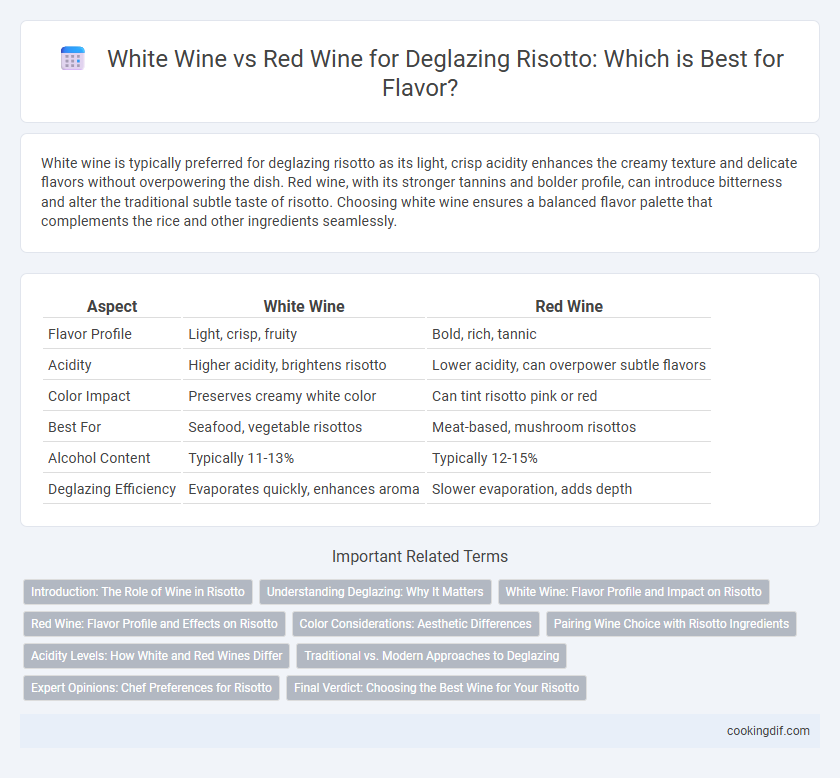White wine is typically preferred for deglazing risotto as its light, crisp acidity enhances the creamy texture and delicate flavors without overpowering the dish. Red wine, with its stronger tannins and bolder profile, can introduce bitterness and alter the traditional subtle taste of risotto. Choosing white wine ensures a balanced flavor palette that complements the rice and other ingredients seamlessly.
Table of Comparison
| Aspect | White Wine | Red Wine |
|---|---|---|
| Flavor Profile | Light, crisp, fruity | Bold, rich, tannic |
| Acidity | Higher acidity, brightens risotto | Lower acidity, can overpower subtle flavors |
| Color Impact | Preserves creamy white color | Can tint risotto pink or red |
| Best For | Seafood, vegetable risottos | Meat-based, mushroom risottos |
| Alcohol Content | Typically 11-13% | Typically 12-15% |
| Deglazing Efficiency | Evaporates quickly, enhances aroma | Slower evaporation, adds depth |
Introduction: The Role of Wine in Risotto
Wine plays a crucial role in risotto by adding depth and complexity to its flavor profile through deglazing. White wine is traditionally preferred for its acidity and lightness, which enhance the subtle creamy texture without overpowering the dish. Red wine, though less common, can introduce richer, bolder notes but risks altering the delicate balance characteristic of classic risotto.
Understanding Deglazing: Why It Matters
Deglazing with white wine in risotto enhances the dish's brightness and preserves its delicate flavors through mild acidity and subtle fruitiness, crucial for balanced taste. Red wine introduces robust tannins and deep color, which can overpower risotto's creamy texture and nuanced ingredients, altering its traditional profile. Understanding the choice between white and red wine in deglazing is essential for achieving the desired flavor harmony and texture in authentic risotto preparation.
White Wine: Flavor Profile and Impact on Risotto
White wine offers a crisp acidity with floral and citrus notes that enhance the delicate flavors of risotto without overpowering them. Its light-bodied profile helps lift the dish by balancing the creaminess of the rice and adding a subtle fruity brightness. Using white wine for deglazing unlocks layers of complexity while maintaining the risotto's traditional, harmonious taste.
Red Wine: Flavor Profile and Effects on Risotto
Red wine imparts a bold, robust flavor to risotto, introducing deep berry and earthy notes that complement rich ingredients like mushrooms and beef. The tannins in red wine contribute to a slightly firmer texture and a complex, savory depth, enhancing the dish's overall umami profile. Using red wine for deglazing adds a vibrant color and intensifies the aroma, creating a luxurious and hearty risotto experience.
Color Considerations: Aesthetic Differences
White wine is preferred for deglazing risotto due to its clear, pale color that maintains the dish's creamy appearance and does not alter the traditional light hue. Red wine can impart a reddish or purple tint, which may clash with the classic white or golden tones of risotto and affect its visual appeal. Maintaining the authentic color through white wine deglazing ensures the dish retains its expected aesthetic and presentation.
Pairing Wine Choice with Risotto Ingredients
White wine is traditionally preferred for deglazing risotto due to its crisp acidity, which complements delicate ingredients like seafood, chicken, and vegetables by enhancing their natural flavors. Red wine, with its bolder tannins and richer profile, pairs better with heartier risottos featuring mushrooms, beef, or aged cheeses, adding depth and complexity to the dish. Selecting the right wine for deglazing aligns the flavor intensity and aroma with the risotto's primary ingredients, ensuring a balanced and harmonious taste experience.
Acidity Levels: How White and Red Wines Differ
White wine typically features higher acidity levels than red wine, making it ideal for deglazing risotto by enhancing brightness and balancing creamy textures. Red wine's lower acidity and richer tannins can overpower the delicate flavors, resulting in a heavier taste profile. Choosing white wine preserves the dish's lightness while amplifying the subtle nuances of the grains and broth.
Traditional vs. Modern Approaches to Deglazing
Traditional risotto recipes favor white wine for deglazing due to its acidity and light flavor, which enhances the creamy texture without overpowering the dish. Modern approaches experiment with red wine, introducing richer tannins and deeper color that create a bolder, more robust flavor profile. Choosing between white and red wine for deglazing hinges on balancing the delicate nature of Arborio rice with the desired intensity and complexity in the final risotto.
Expert Opinions: Chef Preferences for Risotto
Chef experts widely prefer white wine for deglazing risotto due to its ability to enhance the dish's delicate flavors without overpowering the creamy texture. White wine's higher acidity helps balance the richness of Arborio rice, creating a harmonious flavor profile essential in classic risotto recipes. Red wine, with its robust tannins and deeper color, is rarely chosen by professionals as it can overshadow the subtle nuances of the dish and alter its traditional appearance.
Final Verdict: Choosing the Best Wine for Your Risotto
White wine is the preferred choice for deglazing risotto due to its light, crisp acidity that enhances the dish's creamy texture and delicate flavors. Red wine can overpower the subtlety of the risotto with its bold tannins and richer taste profile, potentially altering the classic character. For the best risotto, opt for a dry white wine like Sauvignon Blanc or Pinot Grigio to achieve optimal flavor balance and brightness.
White wine vs red wine for deglazing Infographic

 cookingdif.com
cookingdif.com